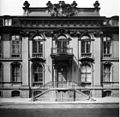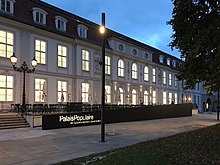Princesses Palace

The Prinzessinnenpalais on the boulevard Unter den Linden 5 in the Berlin district of Mitte is a former palace of the Hohenzollern family . It was built in 1733 by Friedrich Wilhelm Diterichs in the Rococo style and expanded in the classicism style by Heinrich Gentz from 1810–1811 . In the Second World War, burned and demolished in 1962, it was from 1963 to 1964 by Richard Paulick reconstructed as Operncafé. Since 2018, it has been home to the art, culture and sports forum PalaisPopulaire of Deutsche Bank .
history

In 1733 joined Frederick William Dieterich's two 1730 for the General of Becheffer and Finance Minister Freiherr von Cocceji in Oberwallstrasse at Berlin moat built building by insertion of a central projection to a new transverse to the Unter den Linden standing palace, Cocceji until his Death inhabited. Margrave Friedrich Heinrich von Brandenburg-Schwedt acquired the building in 1755. In 1788 the royal family inherited it. In 1811 it was extended to the street Unter den Linden according to plans by Heinrich Gentz with a representative head building and connected to the Kronprinzenpalais by Karl Friedrich Schinkel by means of a candle arch . Since this renovation for the daughters of King Friedrich Wilhelm III. the name Prinzessinnenpalais was in use, but they never lived in it.
Various members of the Prussian ruling family, such as the widow of Emperor Friedrich III, lived in the palace until 1918 . , but also officials. From 1931 the Schinkel Museum was set up in the rooms. After it was almost completely destroyed in World War II and the ruins were torn down between 1960 and 1962, the palace was reconstructed as an opera café between 1962 and 1964 according to plans by Richard Paulick as part of the overall restoration of the Friedrichsforum . The interior received a modern equipment. The rococo stair railing of the Berlin-Buch Palace , a work by Diterichs from 1736 that was torn down in 1964, is historically valuable .
In the following years the opera café quickly developed into a popular meeting place for locals and tourists. It also served as the location for The Legend of Paul and Paula , one of the most successful feature films in the GDR . Weekly disco evenings were held in the Prinzessinnenpalais for the East Berlin gay scene.
After German reunification , the building came into the possession of the federal government through the unification agreement , which was now part of the TLG Immobilien GmbH portfolio . In consultation with the owner, the café operator Manfred Otte had the historicizing wall coverings removed. In 2012 the federal government amicably canceled the lease agreement with the operator of the opera café . The premises became vacant and were for sale.
- Picture gallery
West facade on Bebelplatz , 1968
Princess garden with offset Yorck statue, 1965
PalaisPopulaire
In 2014, the CEO of Axel Springer Verlag , Mathias Döpfner , acquired the Palais and had it converted by David Chipperfield . Döpfner rented the entire building to Deutsche Bank in 2017 , which will use it as a platform for art, culture and sport after extensive renovation work. The architectural office Kuehn Malvezzi worked out the conversion plans, according to which bright, airy rooms should be created. At the same time, the historical scars , i.e. the reinforced concrete pillars and steel beams from the 1960s reconstruction are to be made visible. The contrast between the historicizing facades and the modern interior should be emphasized. The walls are clad in white, however, and the windows can be optimally adapted to the lighting conditions using gauze and technology.
On September 27, 2018, the new art, culture and sports center was opened under the name PalaisPopulaire . The previously closed passage between Oberwallstrasse and the garden of the Palais will be opened and a new restaurant will be set up to the side of the new foyer. The catering company Kofler & Co. was won over as operator . This aims to tie in with old café tradition and offer visitors not only trendy fresh cuisine but also high-calorie Luisen and princess cakes. The old entrance to the palace from the garden, on the other hand, should remain closed, because behind it, in the stairwell, the new center of the art gallery is being built . A studio lounge is planned on the second floor , which is to be used for visitor groups, workshops or receptions.
Princess garden
The garden of the Prinzessinnenpalais (called "Prinzessinnengarten") was created shortly after 1740 by removing the fortress wall that was located behind the palace accessible from Oberwallstrasse. It extended to the opera building, which was built at the same time, and was traversed by the fortress moat, which was called Grüner Graben here . Originally a baroque garden with orangery , it later had a very old, tall tree population as a landscape garden , but was surrounded by a wall and not accessible to visitors. After its destruction in World War II, Rolf Rühle designed it in 1964 in connection with the reconstruction of the Prinzessinnenpalais as part of the Bebelplatz as a public park. In the western part of the garden was the eastern ramp of the linden tunnel between 1914 and 1951 , which served the tram as an underpass for the "Linden". The base of the Blücher monument had to be reinforced for the construction, as it was located above the driveway. The ramp was filled in after the tunnel was closed.
In the front part of the garden there were the bronze statues created by Christian Daniel Rauch for Ludwig Yorck von Wartenburg , Gebhard Leberecht von Blücher and August Neidhardt von Gneisenau since 1855 as well as the marble statues for Friedrich Wilhelm von Bülow and Gerhard David von opposite in front of the Neue Wache since 1822 Scharnhorst . They represent the most important generals and reformers of the Wars of Liberation . At the original location they were in connection with the sculpture program designed by Karl Friedrich Schinkel , which ranged from the warriors on the castle bridge over the Victoria at the portico of the Neue Wache to the equestrian statue of Frederick the Great on Unter den Linden. On the orders of SED chief Walter Ulbricht , the general statues were removed and stored in 1950. The bronze statues were placed in the rear part of the garden when the green area was redesigned in 1964, and the marble statues in the front part of the garden after the restoration in 2002. Citizens and experts are calling for the five statues to be put back at their original location, but the State Monument Council has so far refused.
literature
- Hermann Heckmann : Builder of the Baroque and Rococo in Brandenburg-Prussia. Verlag für Bauwesen, Berlin 1998, ISBN 3-345-00631-6 , p. 332 (Schloss Buch), p. 334–335 (Prinzessinnenpalais).
- Folkwin Wendland: Berlin's gardens and parks from the founding of the city to the end of the nineteenth century: The classic Berlin. Propylaea publishing house, Frankfurt a. M., Berlin / Vienna 1979, ISBN 3-549-06645-7 , pp. 55-57.
Web links
- Entry in the Berlin State Monument List with further information
- PalaisPopulaire - art, culture and sports forum of Deutsche Bank
- Prinzessinnenpalais at luise-berlin.de
Individual evidence
- ^ A b c Nikolaus Bernau: Art, sport and cake . In: Berliner Zeitung , February 28, 2018, p. 23.
- ↑ https://dbpp.db.com/de/architektur.htm
- ↑ Berlin: Operncafé Unter den Linden is closed and wakes up again as an automobile showroom - probably ( memento of the original from January 16, 2013 in the Internet Archive ) Info: The archive link was automatically inserted and not yet checked. Please check the original and archive link according to the instructions and then remove this notice. On: gewerbeimmobilien24.de , September 9, 2011, accessed on November 21, 2012.
- ↑ Prinzessinnenpalais Unter den Linden: The future of the Opernpalais remains uncertain. In: Berliner Zeitung , June 9, 2015.
- ↑ A new platform for art, culture and sport: Deutsche Bank opens the PalaisPopulaire in Berlin. Deutsche Bank AG, Frankfurt, accessed on September 1, 2018 .
- ↑ Hans-Joachim Pohl: The Lindentunnel . In: Verkehrsgeschichtliche Blätter . Issue 7, 1980, pp. 134-150 .
- ^ Press release of the Senate Department for Urban Development and the Environment from July 2, 2002 , accessed on May 7, 2015







